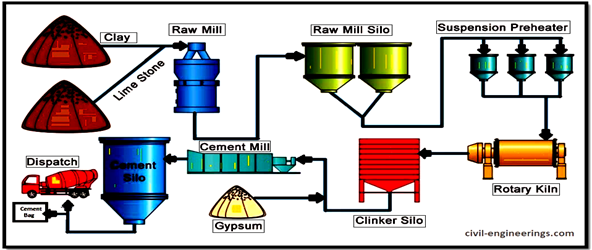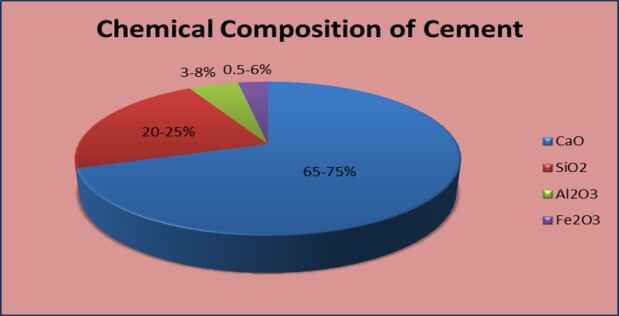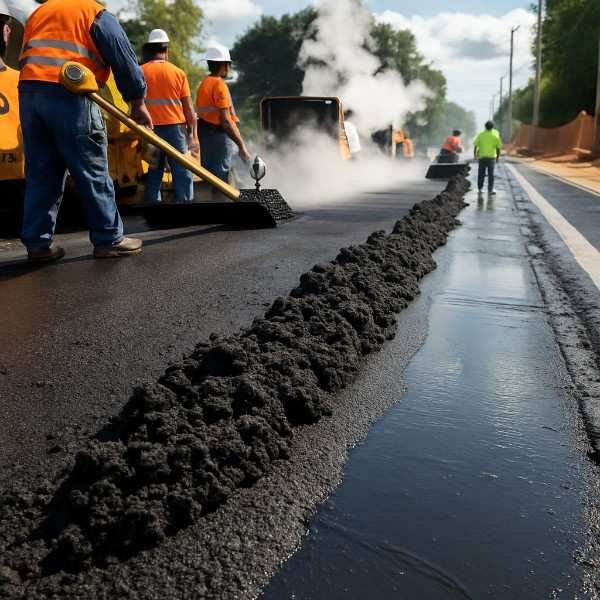Table of Contents
What is Cement?
Cement is a binding material used in construction that sets, hardens, and adheres to other materials to bind them together. It is an essential component of concrete, which is one of the most widely used construction materials globally. Cement works as glue in the concrete that binds the sand and aggregate.
Cement Manufacturing

Cement Manufacturing involves many steps, starting with the extraction of raw materials from the earth and ending with the packaging of the final product. Details of steps are as under:
- Extraction of Raw Materials: The main raw materials used in cement manufacturing are limestone, shale, and sand. These materials are extracted from pits or mines and transported to the cement plant.
- Crushing and Grinding: Raw materials are crushed and ground into a fine powder. This process is usually done in a ball mill, which consists of a rotating drum filled with steel balls.
- Preheating and Pre-calcining: Blended raw materials are then preheated and pre-calcined in a preheater/calciner system. This helps to reduce the energy consumption in the kiln and improve the efficiency of the process.
- Clinker Making: The preheated and pre-calcined raw materials are fed into a rotary kiln, where they are heated to a temperature of about 1450°C (2642°F). At this temperature, raw materials undergo chemical reactions and form clinker.
- Cooling: Clinkers then cooled and ground into a fine powder along with a small amount of gypsum to control the setting time of the cement.
- Packaging and Distribution: The final product, called cement, is then packaged in bags or bulk and distributed to customers.
Chemical Composition of Cement
Cement is mainly composed of four main elements: calcium, silicon, aluminum, and iron. The chemical composition of cement varies depending on the type of cement and the specific application. However, the general chemical composition of ordinary Portland cement (OPC) is as follows:

- CaO (Calcium Oxide): Approximately 65-75% CaO quantity in the Cement. CaO derived from limestone (calcium carbonate) and is the primary constituent responsible for the cement's strength.
- SiO2 (Silicon Dioxide): Approximately 20-25% SiO2 quantity in the Cement. SiO2 is derived from materials such as clay, sand, and shale. Silicon dioxide contributes to the cement's strength and durability.
- Al2O3 (Aluminum Oxide): Typically around 3-8%. It is derived from materials such as clay and shale. Aluminum oxide helps to regulate the setting time of the cement.
- Fe2O3 (Iron Oxide): Typically around 0.5-6%. It is derived from materials such as clay and iron ore. Iron oxide provides color to the cement and also contributes to its strength and durability.
- Other minor constituents: Other minor constituents may also be present in cement, such as magnesium oxide (MgO), sulfur trioxide (SO3), and alkalis (Na2O and K2O), but these are usually present in small amounts and do not significantly affect the cement's properties.
Ingredients of Cement
Cement is composed of several ingredients that are carefully combined and processed to create the final product. The main ingredients of cement include:
- Limestone: Limestone is the primary source of calcium in cement manufacturing. It is typically extracted from quarries and mines and is crushed into small pieces before being used in the cement-making process.
- Clay or Shale: Clay and shale are sources of silica, alumina, and iron, which are important components of cement. These materials are usually mined or quarried and then crushed and mixed with limestone to form a raw meal.
- Sand or Silica: Sand, or silica, provides additional silica to the raw meal, which helps to improve the strength and durability of the final cement product.
- Iron Ore or Mill Scale: Iron ore or mill scale is sometimes added to the raw mix to provide additional iron, which can help to regulate the setting time of the cement.
- Gypsum: Gypsum is added to the clinker during the grinding process. It helps to control the setting time of the cement and is important for preventing flash setting, which can occur when the cement sets too quickly.
Uses of Cement
Cement is a versatile and widely used material in construction due to its strength, durability, and ability to bind other materials together. Some of the common uses of cement include:
- Concrete Production: Cement is a key ingredient in concrete, which is used in a wide range of construction projects, including buildings, bridges, roads, and dams. Concrete is known for its strength, durability, and versatility.
- Mortar Production: Cement is mixed with sand and water to make mortar, which is used to bind bricks or stones together in masonry construction. Mortar provides strength and stability to masonry structures.
- Grout Production: Cement-based grout is used to fill gaps and voids between tiles or bricks, providing a strong and stable surface.
- Stabilization of Soil: Cement can be mixed with soil to improve its strength and stability, making it suitable for construction purposes, such as building foundations or roads.
- Precast Concrete Products: Cement is used to make precast concrete products, such as concrete blocks, pipes, and panels, which are then used in construction projects.
- Repair and Maintenance: Cement-based materials are used for repair and maintenance work, such as patching cracks in concrete structures or resurfacing worn-out surfaces.
- Decorative Purposes: Cement can be used for decorative purposes, such as creating textured finishes on walls or making decorative concrete elements, such as countertops or sculptures.

Storage of Cement
Storing cement is very important to maintain its quality and effectiveness in construction projects. By following these guidelines, you can ensure that your cement remains in optimal condition for use in construction projects.
- Cement should be stored in a dry place to prevent it from absorbing moisture, which can cause it to harden and become lumpy.
- Store cement off the ground on pallets or racks to protect it from moisture and humidity that can seep through concrete floors.
- Cement should be stored in a covered area to protect it from rain, snow, and other forms of precipitation. Use waterproof covering sheets to protect the cement from moisture.
- Ensure proper ventilation in the storage area to prevent the buildup of moisture and humidity, which can lead to the caking of cement.
- Store cement in a cool, dry place whenever possible to maintain its quality. Avoid storing cement in areas that are subject to extreme temperatures or fluctuations.
- Practice FIFO inventory management to ensure that older stock is used first, reducing the risk of cement hardening or deteriorating over time.
- If you need to store cement for an extended period, consider transferring it to sealed containers, such as bins or bags, to protect it from moisture and humidity.
- When handling cement bags, avoid tearing or damaging them, as this can expose the cement to moisture. Use gloves and masks to protect yourself from dust.
Types of Cement
Various types of Cement commonly used in Concrete works are given below. Cement shall conform to the specifications for Portland Cement ASTM C-150 / BS-12, unless otherwise specified to be of any particular quality, shall mean Ordinary Portland Cement.
| Type | Use |
|---|---|
| I | Ordinary Portland Cement; General purpose cement, when there are no extenuating conditions |
| II | Modified Cement; Aids in providing moderate resistance to Sulphate attack |
| III | Rapid Hardening Cement; When high-early strength is required |
| IV | Low Heat Cement; When low heat of hydration is desired (in massive structures) |
| V | Sulphate Resistant Cement; When high Sulphate resistance is required |
| I A | Type I Cement, containing an integral air-entraining agent |
| II A | Type II Cement, containing an integral air-entraining agent |
| III A | Type III Cement, containing an integral air-entraining agent |
Conclusion
Cement is a fundamental building material that plays a vital role in the construction industry. Despite its importance, the environmental impact of cement production cannot be overlooked. The industry is increasingly adopting sustainable practices to reduce carbon emissions and minimize environmental degradation. It is important for both producers and consumers to be aware of these efforts and support initiatives that promote sustainable cement production.






